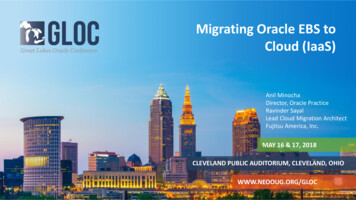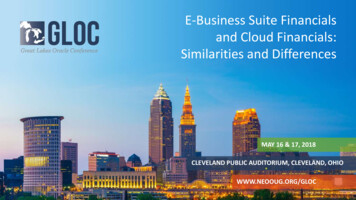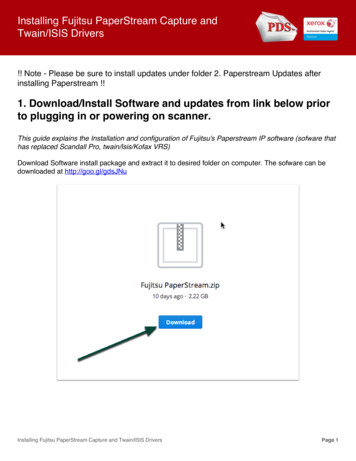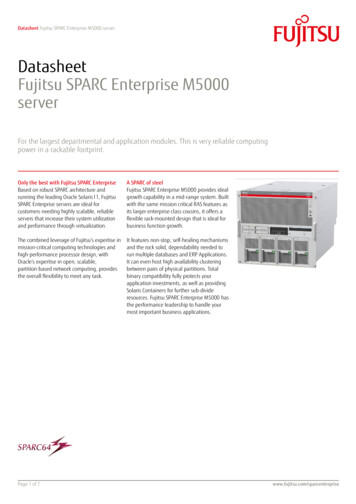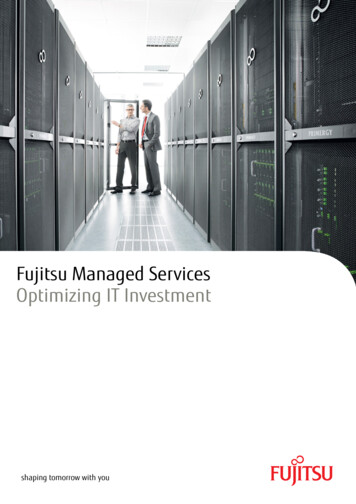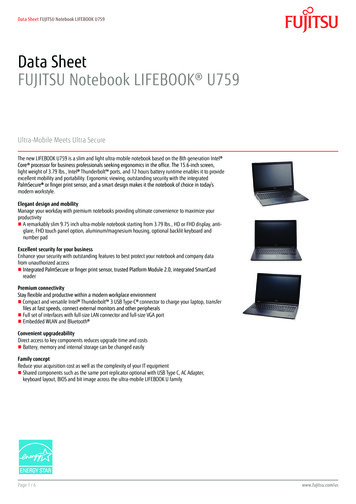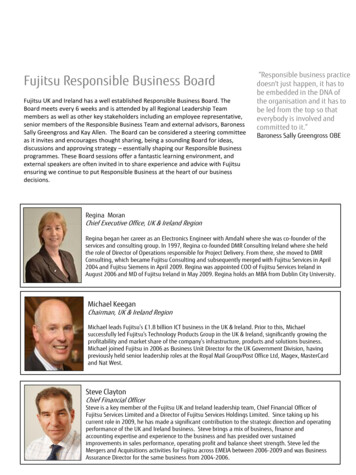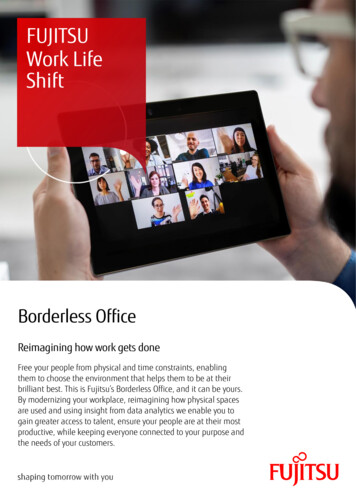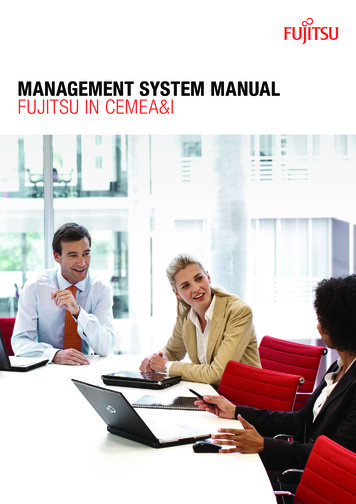
Transcription
MANAGEMENT SYSTEM MANUALFUJITSU IN CEMEA&I
ContentsPreface1.Presentation of company, visions and objectives1.1 Fujitsu Group and Fujitsu Global Business Group1.2 The Fujitsu Way1.3 Fujitsu in CEMEA&I1.4 Vision, mission and strategy1.5 Corporate objectives1.6 Responsibility and delegation1.6.1 Management Council1.6.2 Delegation of entrepreneurial responsibilities1.6.3 Quality Representative1.7 Organizational 4.12.4.22.4.32.4.42.4.52.4.62.4.72Integrated Management System (IMS)Management system principlesObjectives of integrated management systemCertified systems/standardsQuality Management (EN ISO 9001:2008)Environment Management (EN ISO 14001:2004)IT Service Management (ISO/IEC 20000-1:2005)Information Security Management (ISO/IEC 27001:2005)Scope of standardsAdditional management concepts, laws and regulationsCompliance and ethicsBusiness Continuity ManagementRisk ManagementEscalation and Crisis ManagementOccupational Health & Safety (OHS)Product Safety and LiabilityCorporate 6163.3.13.23.33.43.5Process framework and documentationProcess orientationProcess architectureProcess managementDocumentation of the integrated management systemDocument , improvement and innovationCustomer satisfactionMeasurementContinual improvementInnovationAudits, assessments and management system ment of resourcesProvision of resourcesHuman resourcesAssignmentEmployee development and trainingCompensation and benefitsInfrastructure23232323232323
PREFACESatisfied customers, motivated and committed employees aswell as a positive atmosphere are pre-requisites for the durableeconomic success of our company. Market-driven prices,quality of products and services, plus stable tools and workflows guarantee customer satisfaction and the protection ofboth employees and the environment.The integrated management system provides our customers,partners, employees, suppliers and shareholders with an insightinto what we do and how we do it. While it is basically designedfor the benefit of our customers, it also acts as a guideline forour employees to ensure successful action and interactionwithin our business processes.To permanently meet this significant challenge, we havedeveloped and implemented our management systems in oneintegrated management system.This manual provides an overview of the integrated quality,environment, information security and IT service managementsystems that have been established at Fujitsu in CEMEA&I,together with their structure and operations*.This integrated management system forms the basis and themeans to ensure the operative implementation of our strategicobjectives. It comprises all those main activities that guaranteecustomer benefit, sustainability, and stability. It is focused onour business processes, our work methods, and our corporateculture.Released October 2010Heribert GöggerleExecutive Vice PresidentArmin KumpfSenior DirectorQuality Management*) in the context of this document the term “Fujitsu in CEMEA&I” covers the completeorganisation of Fujitsu Technology Solutions (FTS) and Fujitsu Services (FS) inContinental Europe, Middle East, Africa and IndiaCorporate Certificates3
1. PRESENTATION OF COMPANYVISIONS AND OBJECTIVES1.1 FUJITSU GROUP AND FUJITSU GLOBAL BUSINESS GROUPFujitsu – headquartered in Tokyo – is a leading provider of ITbased business solutions for the global marketplace. Approximately 172,000 employees support customers in more than 70countries.The Fujitsu Group is divided into five regions, namely Japan,the Americas, Asia & Pacific (APAC), China, and Europe,Middle East and Africa (EMEA). The EMEA region consists ofthe three sub-regions Continental Europe, UK & Ireland andNordics, where the sub-region Continental Europe is coveredby Fujitsu Technology Solutions.All operations outside Japan build the Global Business Group(GBG) - including Fujitsu Technology Solutions and FujitsuServices - and comprise such consolidated global functions asglobal marketing, global delivery and global client management.The Continental Europe, Middle East and Africa, plus Indiaregion (CEMEA&I) is part of the Global Business Group and4covers most of Fujitsu Technology Solutions’ territory. It isheaded by a Chief Executive Officer (CEO), who is alsoPresident & CEO of Fujitsu Technology Solutions.The execution and transformation of the Fujitsu Group’s business strategy is steered from the Global Business Group headquarters in London.1.2 THE FUJITSU WAYThe Fujitsu Way embodies the philosophy of the Fujitsu Group,our reason for existence, our values, and the principles that wefollow in our daily business. The complete description is available at ophy/.Based on a thorough understanding of its components, we fullyembrace the Fujitsu Way so that our conduct naturally reflectsits spirit and intent. Especially when faced with difficult decisions, we use the Fujitsu Way to guide our actions.( see figure page 5)
FUJITSU WAYCORPORATE VISIONThe reasons for the existence of the Fujitsu GroupCORPORATE VALUESA set of value statements for achieving our Corporate VisionPRINCIPLESThe principles we adhere to in all business dealings andactions in accordance with Corporate ValuesCODE OF CONDUCTThe rules and guidelines followed byeveryone in the Fujitsu GroupBUSINESS POLICYOur current Strategies pursued in accordancewith the Fujitsu WayElements of the Fujitsu Way5
1.3. FUJITSU IN CEMEA&I1.4 VISION, MISSION, AND STRATEGYThe Continental Europe, Middle East and Africa, plus Indiaregion (CEMEA&I) is part of the Global Business Group. Thisterritory is mainly covered by legal entities of Fujitsu Technology Solutions (FTS) and Fujitsu Services (FS) – hereinaftercalled as Fujitsu in CEMEA&I. It is headed by a Chief Executive Officer (CEO).The vision of Fujitsu in CEMEA&I is derived from the GlobalBusiness Group to become a Tier 1 trans-national IT provider,uniquely differentiated by its Japanese parentage. Transnational, for us, is summarized by the expression “Think Global, ActLocal” – we are globally capable, but at the same time locallyresponsive to our customers’ needs.Fujitsu in CEMEA&I is a leading IT infrastructure providerwith a presence in all key markets in Europe, the Middle Eastand Africa, plus India, serving large, medium, and small-sizedenterprises, as well as consumers.During the period of our strategic Mid-Term Plan (MTP)Fujitsu intends to substantially increase the percentage of itsbusiness outside Japan. The Global Business Group is crucialto achieving this ambition. We have three goals over the MTPperiod: To act on a focused set of growth initiatives which will driveus deeper into selected vertical industry sectors, while simultaneously developing innovative offerings targeted at bothmature and developing markets around the globe. To build differentiation externally, by bringing products andservices to market together and presenting “One Fujitsu” toour customers. To configure ourselves for efficiency. We will simplify andtransform our regional organizations to meet the needs ofour global clients, and derive lasting benefits from bestpractice and standardized offerings across the regions.With its business approach the company offers a full portfolioof IT products, solutions and services, ranging from clients todatacenter solutions, Infrastructure-as-a-Service and ManagedInfrastructure.TDS is also a Group member – since 2007. Headquartered inNeckarsulm, Germany, it currently employs more than 1,100staff at some 20 sites in Germany, Austria and Switzerland. Asoutlined later, TDS applies its own management system.The Fujitsu in CEMEA&I is a cornerstone of this internationalorganization. We have the potential – and also the obligation –to implement the model in an exemplary manner.Our key strategies are: Become a leading IT infrastructure and service provider bymoving up the value chain. Provide customers with a complete portfolio of DynamicInfrastructures, Application Services, and Business Services –fitting their needs. Create a common approach to all cloud computing stacksthat will successfully attract customers – based on partnerships inside and outside of the Fujitsu organization.6
1.5 CORPORATE OBJECTIVES1.6.2 DELEGATION OF ENTREPRENEURIAL RESPONSIBILITIESEach year clearly defined operative corporate objectives arepresented by the Chief Executive Officer (CEO) and the Management Council (MC) for the individual divisions andsubsidiaries.The fulfillment of delegated tasks, which arise from entrepreneurial duties, is organized and documented.The corporate objectives are drawn up by the Corporate Strategy and Finance & Controlling departments and presentedfor approval. They are developed in a budgeting process basedon market data, general trends, and the specific strengths andimprovement potential provided by Fujitsu in CEMEA&I.Medium-term aspects (3-year plan summary) are also takeninto account.Furthermore, corporate objectives regarding such importanttopics as quality, service management, information security andenvironment management are specified as general targets andprograms.1.6 RESPONSIBILITY AND DELEGATIONA prerequisite for the implementation and fulfillment of ourstrategic targets is an organization with an organizational andoperative lucidity and the clear assignment of tasks, competencies, resources, and responsibilities.1.6.1 MANAGEMENT COUNCILThe Management Council (MC) under the direction of theChief Executive Officer (CEO) sets the business targets anddecides on the strategies for Fujitsu in CEMEA&I.The Management Council comprises our business functions(Technology Solutions Portfolio, Service Operations, SupplyOperations, Regional Sales Clusters, Finance and our indirectchannel business) and is assisted by our Business Supportfunctions. Important managerial elements for the MC are thestrategic and operative planning processes as well as targetagreements with the regional and functional units. Planningand reporting is based on business according to the countries,regions, product lines, and market segments.This delegation comprises the selection of suitable employees, their instruction and monitoring. It begins with theexecutive management, which has the overall responsibility, and proceeds across different management levels downto the employee concerned.The assignment of duties is combined with the assignmentof competencies. They are all interrelated in a suitable manner. The relevant tasks, responsibilities and competenciesare documented in job profiles and procedures.1.6.3 QUALITY REPRESENTATIVEThe management council is responsible for setting up,maintaining and developing the management system regarding quality, environment, information security and ITservice management as described in chapter 3. A dedicatedmember of the management council controls the properfunction of these systems besides entrepreuneurial responsibilities on a four eyes principle.Specialized compliance officers are appointed based on legaland business need for specific topics such as Environmental protection IT security Product safety Occupational health and safety7
1.7 ORGANIZATIONAL STRUCTUREThe main feature of our business model is its clear alignmentaccording to the business responsibilities of each operativefunction and their interaction: Sales (South-Eastern Europe,Southern & Western Europe, Germany, Emerging Markets),Supply Operations, Service Operations, Technology SolutionsPortfolio and Corporate Functions.( see figure page 9)We position this responsibility as closely to the customer aspossible – and in the interest of the customer, namely in thecountry organizations, which are members of the Sales organization. The Fujitsu in CEMEA&I business model is characterized by the clear focus on business responsibilities of theoperative functions and their cooperation: Sales, SupplyOperations, Service Operations, Technology SolutionsPortfolio, and Support Functions.Sales is divided into four regional infrastructure sales organizations so as to strengthen our customer proximity, simplifyour processes, make us stronger locally, as well as to suitablyalign the infrastructure products, solutions, and infrastructureservices to our Dynamic Infrastructures Portfolio.Supply Operations is instrumental in ensuring that we candeliver the products and solutions that our customers need tobe successful in their business. Supply Operations is responsiblefor the economical procurement, manufacturing, and logistics(both inbound and outbound) of the products. Continuouslyoptimizing its end-to-end processes along the value chain,Supply Operations achieves best-in-class product, service anddelivery quality.8Service Operations is a business function that acts as theinterface between the Technology Solutions Portfolio (TSP)and the Sales regions to ensure that we can deliver and implement as promised. Service Operations puts its entire focus onService Delivery and offers the appropriate governance,experience, and central delivery capabilities.Technology Solutions Portfolio defines, develops, and implements our products and services, infrastructure solutions, andmanaged infrastructures, as well as our “Infrastructure as aService“ offerings in a joint portfolio of platforms and services.TSP is responsible for its part in our Dynamic Infrastructuresportfolio throughout the entire lifecycle, and thus needs toensure an end-to-end approach to its implementation.Corporate Functions are Finance, Channel, Region Support,Legal Services, Human Resources, Information Systems, Communication, Strategy and others.
ERN &WESTERN EUROPESUPPLY OPERATIONSGERMANYEMERGING MARKETSSERVICE OPERATIONSTECHNOLOGY SOLUTIONS PORTFOLIOOrganization Chart Fujitsu in CEMEA&I9
2. INTEGRATED MANAGEMENTSYSTEM (IMS)In general, management systems are tools for the realizationof entrepreneurial targets. They configure the relevant basicrequirements of operational activities and support businessprocesses. This is enabled by the implementation of operationaland organizational structures and the corresponding rules, aswell as internal reviews, e.g. by means of audits. The introduction of a process-specific system for measuring performance isessential for enabling the assessment of processes.2.1 MANAGEMENT SYSTEM PRINCIPLESIn order to facilitate synergies, Fujitsu in CEMEA&I hasconsolidated various management systems into one integratedmanagement system. ( see figure page 10)This IMS supports employees and management in the transformation of legal requirements and verbalized guidelines derivedfrom our vision and the corresponding company’s objectives.Our integrated management system defines: Where we want to go. Who is responsible. How targets are precisely met. How improvements are systematically transformed.A management system can only reveal its full effect once all important processes are identified, described, and integrated intothe general management and have really become an integralpart of our daily business.2.2 OBJECTIVES OF THE INTEGRATED MANAGEMENT SYSTEMThe objectives of the Fujitsu in CEMEA&I integrated management systems are: Improvement of process performance, including additionalrequirements from spheres of activity, especially qualitymanagement, environmental management, IT service management, information security and additional managementsystems, Reduction of risks due to ambiguous organizations, structures, and workflows, Retention of conformance to laws by compliance with corresponding legal requirements and contractual agreements, Optimization of MENTIT TIONALMANAGEMENTSYSTEMSFULFILLMENT OFCUSTOMERREQUIREMENTSREDUCTION OFENVIRONMENTALIMPACTEFFICIENCY BY ITSERVICEMANAGEMENTEFFECTIVE RISKREDUCTION, CONSTANTFULFILLMENTOFREQUIREMENTSAS DESCRIBEDIN CHAPTER 2.4Our Integrated Management System10
2.3 CERTIFIED SYSTEMS2.3.1 QUALITY MANAGEMENT (EN ISO 9001:2008)Our products and services for customers are based on globallyvalid guidelines and laws, including the relevant standards.Relevant corporate and local specifications and regulations canbe accessed by all employees via the Intranet. Specific regulations are accessible only for authorized users and are stored inrestricted areas of our information systems.General targets have been defined based on our quality policy,“We enhance the reputation of our customers and the reliability of social infrastructure”: Outstanding quality is essential for our customers and forour success. We stick to our company values and ethical principles. Process oriented (model).Governance and specific control mechanisms are a prerequisiteto managing and operating the IMS for the certified systems.The Quality Representative of the company – assigned bythe CEO – is responsible for the overall management of thissystem.As a consequence of the Fujitsu Way, where quality is definedas an essential value, the absolute minimum requirementsfor all our activities must adhere to the following standards: Quality Management Environmental Management IT Service Management Information Security ManagementThese general targets are subdivided by the individual organization units. Individual targets and measures are definedwithin the process descriptions. The documentation andinteraction is checked in internal audits.The quality objectives of our portfolio are already definedduring the development phase by our Technology SolutionsPortfolio organization. These targets are forwarded via theproduct introduction to Service Operations and to SupplyOperations.11
2.3.2 ENVIRONMENTAL MANAGEMENT (ISO 14001:2004)In recent years, Fujitsu has accelerated its green IT initiatives invarious regions outside Japan by combining the strengths of itsworldwide operations and leveraging its technological expertiseand environmental program experience.For years now, we have been operating an environmental management system in accordance with the international standardISO14001 as the basis of all activities. We are strengthening“sustainable management” and aim to improve on our environmental performance.As part of this expansion, Fujitsu has created new global targetsfor the Green Policy Innovation program, aiming to reduceCO2 emissions worldwide. The global expansion of the programwill help customers around the world reduce their environmental footprint while serving as a pillar for the company’smedium-term environmental vision, Green Policy 2020.( see figure page 12)REDUCING CUSTOMERS’ ENVIRONMENTAL LOAD BY ITOFFERING TO CUSTOMERSFUJITSU GREEN ITREDUCTIONS INENVIRONMENTAL LOADBY ITGREEN POLICY SOLUTIONSSOFTWARE/SERVICES(OUTSOURCING, CONSULTING)REDUCTIONS INENVIRONMENTAL LOADOF ITGREEN POLICY PRODUCTS (IT INFRASTRUCTURES)PLATFORMS, NETWORKS, SOFTWARE, UBIQUITOUS NETWORK PRODUCTS,ELECTRIC DEVICES, SEMI-CONDUCTORSBUSINESS AREAR&D, DESIGN, MANUFACTURING, PROCUREMENT,LOGISTICS AND RECYCLINGGreen Policy12ENVIRONMENTALKNOW-HOW FROMIN-HOUSE EXPERTISE
2.3.3 IT SERVICE MANAGEMENT (ISO/IEC 20000-1:2005)The ISO/IEC 20000 standard promotes the adoption of an integrated process approach to effectively deliver managed servicesso as to meet business and customer requirements.( see figure page 13)A coordinated integration and implementation of the servicemanagement processes allows for ongoing control, greaterefficiency and opportunities for continual improvement. TheISO/IEC 20000 defines the requirements for delivering managed services at an acceptable quality for our customers.Standardized IT Service Management processes conformingto ISO 20000 have been defined and introduced throughoutthe entire Fujitsu CEMEA & I Region based on our corporatestrategy. The transformation of the standard’s requirementsis detailed in a management system for service.ISMS implementation will be scaled in accordance with theneeds of the organization, e.g. a simple situation requires asimple ISMS solution.Fujitsu in CEMEA&I has established an “InformationSecurity Policy” and an “Information Security ManagementSystem (ISMS)” based on the following principles: Information is only available to authorized users. Data is protected against loss or manipulation. Information can be clearly assigned to a responsibleperson. Anti-virus measures are implemented everywhere – at alllevels. Central contact persons for such topics are named byeach department. Constant control processes are established, supported byinternal audits.2.3.5 SCOPE OF STANDARDS2.3.4 INFORMATION SECURITY MANAGEMENT (ISO/IEC 27001:2005)The adoption of an ISMS should be a strategic decision for anorganization. The design and implementation of an organization’s ISMS is influenced by its needs and objectives, securityrequirements, the processes employed, plus the size and structure of the organization. It is anticipated that these and theirsupporting systems will change over time. It is expected that anThe ISO 9001 and ISO 14001 standards apply for all employees of Fujitsu in CEMEA&I.ISO 20000 and ISO 27001 basically apply to the employeesinvolved in the provision of managed services to customers.TDS applies its own Management System.SERVICE DELIVERY PROCESSES apacity ManagementC S ervice ContinuityManagement Availability ManagementS ervice Level Management S evices Reporting I nformation SecurityManagement B udgeting and Accountingfor IT sevicesCONTROL PROCESSESConfiguration ManagementChange ManagementRELEASE PROCESS R elease ManagementRESOLUTION PROCESSESI ncident Management P roblem ManagementRELATIONSHIP PROCESSES B usiness RelationshipManagement S upplier ManagementOverview of IT Service Management Process13
2.4 ADDITIONAL MANAGEMENT CONCEPTS, LAWS ANDREGULATIONSWhile the term “integrated management system” is often usedto describe “a system to meet the requirements of more thanone external standard”, we consider it as a “system of integratedmanagement”, which requires the understanding, integration, and application of additional concepts, frameworks, andrequirements.2.4.1 COMPLIANCE AND ETHICSIntegrity is a key factor of sustainable business success andthe backbone of good corporate governance. Additionally, compliance has become an even more important aspect of doingbusiness. Customers, business partners, our shareholders, andthe public alike scrutinize how businesses approach compliance.For this very reason, we established an Ethics Policy whenFujitsu in CEMEA&I was formed and we decided to furtherdevelop it into a more comprehensive Corporate ComplianceProgram. Every one of us must be aware of, understand, and becommitted to conducting Fujitsu’s business in a manner that isconsistent with the highest ethical and legal standards.142.4.2 BUSINESS CONTINUITY MANAGEMENTThe aim of Business Continuity Management is to ensure thecapability of the company to act in the event of a contingency.This is done by continuously reducing the risks involved inbusiness processes. Business continuity is supported by aprocess for the planning and implementation of risk-minimizing measures.All the identified process risks are included in the risk inventory and weighted with a risk potential index. This index is madeup of the economic/financial impact, possible damage to thecompany’s image, probability of occurrence and the probabilityof non-identification. Possible corrective measures, including the costs, are planned and the residual risk after possibleimplementation calculated. The decision-maker derives a cost/benefit analysis from this information and commissions theimplementation of the necessary measures.Thus, when delivering services and products for its customers,Fujitsu in CEMEA&I ensures that in the event of operationalfailure contingency concepts/planning are available for centraland regional processes and operations, which either rule outany possible damage to the customer’s business, or keep it to aminimum. The aim is not to let the customer’s business sufferunder the circumstances.
2.4.3 RISK MANAGEMENTFujitsu in CEMEA&I is subject to a wide variety of risks ineach of its areas of activity, including development and production, as well as sales of IT hardware, software, solutions, andservices.In view of this strongly diversified risk portfolio, the ExecutiveManagement of Fujitsu in CEMEA&I regards an efficient andanticipatory uniform risk management approach and programas a core element of good corporate governance and a keyelement for the success of Fujitsu’s entrepreneurial activities.tion of corrective actions. The main goal is to restore customersatisfaction. Its purpose is also towards preventing escalationsand crisis situations as well as improving and optimizing processes, services, and products (lessons learned). The target is toincrease operational efficiency in customer projects.Escalation and crisis management acts across functions forTechnology Solutions Portfolio, Supply Operation, ServiceOperations and for regions throughout the world.2.4.5 OCCUPATIONAL HEALTH AND SAFETY (OHS)In addition, the company’s commercial success depends to aconsiderable degree on the effective management of opportunities and risks in complex projects. Therefore, Fujitsu inCEMEA&I has developed a common, systematic and comprehensive project risk management system that tracks andsupports every single project.2.4.4 ESCALATION AND CRISIS MANAGEMENTA crisis is the highest level of escalation, and can only bedeclared within Fujitsu in CEMEA&I by the Sales organization. Escalation and crisis management provides specializedand qualified management in critical project and customersituations. It coordinates solution finding and the implementa-Occupational health and safety is not just a management task,but also a constant obligation for all employees, as part of theirown responsibility in implementing effective work protectionmeasures. It is based on legal requirements applicable to theorganization and management and creates a people-centricworking environment. The aims of health and safety at workare achieved through: Preventive work and safety measures to protect employeesand customers. Assessment and reduction of risks through corrective measures. Active integration and cooperation of employees.15
2.4.6 PRODUCT SAFETY AND LIABILITYAll products placed on the market must comply with relevantsafety directives to avoid any personal or property damage.Any reasonably foreseeable risks that a product might poseto a customer during its intended use must be prevented.Internal company guidelines define how legal and standardcompany regulations for product safety and liability are tobe met. Our authorized test laboratories guarantee that ourproducts conform to the requirements of the relevant safetystandards.State-of-the-art technology protects against possible productrisks, such as fire, hazardous voltages, mechanical and chemical hazards, radiation, and more. A comprehensive process hasbeen introduced to cover product liability and possible damages in the field.2.4.7 CORPORATE FINANCEFujitsu in CEMEA & I follows established legal principles offinancial reporting. which are based on the InternationalFinancial Report Standards (IFRS). As a full member of theFujitsu family, Fujitsu in CEMEA & I is additionally requiredto comply with J-SOX, which is the informal name for thelegislative framework of internal controls governing financialreporting. It falls within the scope of the Japanese FinancialInstruments and Stock Exchange Law. J-SOX is the Japaneseequivalent of the better-known Sarbanes-Oxley (SOX) Act of2002 passed by the US government, which reformed publiccompany accounting and protects investors.16Corporate Finance is directly linked to the Chief Financial Officer and consists of the controlling responsibilities for the Salesand Service organizations, as well as all headquarter functions.All relevant financial principles and processes are described indedicated documents. The main components of the system arethe budget, forecast, and the reporting process.The aim of the annual budget process is to set targets andmeasurements for each business entity that are in line withthe company goals by reflecting the strategic direction whileconsidering the current product portfolio as well as engagedresources. Once the budget is approved, it will be compared toalmost every key figure during the fiscal year in order to identify gaps and objections at the earliest possible opportunity,and so take actions for further improvement.The forecast process provides an outlook for the near future tobe proactive in taking countermeasures in order to avoid negative budget deviations before they become reality.Reporting processes are based on dedicated analysis and querytools retrieving their data from several data warehouses anddatabases.
3. PROCESS FRAMEWORK ANDDOCUMENTATION3.1 PROCESS ORIENTATIONThe assembly of our holistic management systems is based onour business processes, which must fulfill standard requirements with regard to Quality, Environment, IT Service andInformation Security Management. The key component in theassembly of our management system is the process orientation.( see figure page 17)IMSQUALITYMANAGEMENTENVIRONMENTALMANAGEMENTIT STOMERMANAGEMENTPROCESSESSUPPORTPROCESSESProcesses in an Integrated Management System17
3.2 PROCESS ARCHITECTURE3.3 PROCESS MANAGEMENTThe core component of the Fujitsu in CEMEA&I process management framework is the process architecture/process house.( see figure page 19)The Fujitsu in CEMEA&I business processes are defined,described and managed in a standardized manner as defined inthe process management
1.6.3 Quality Representative 7 1.7 Organizational structure 8 2. Integrated Management System (IMS) 10 2.1 Management system principles 10 2.2 Objectives of integrated management system 10 2.3 Certified systems/standards 11 2.3.1 Quality Management (EN ISO 9001:2008) 11 2.3.2 Environment Management (EN ISO 14001:2004) 12

